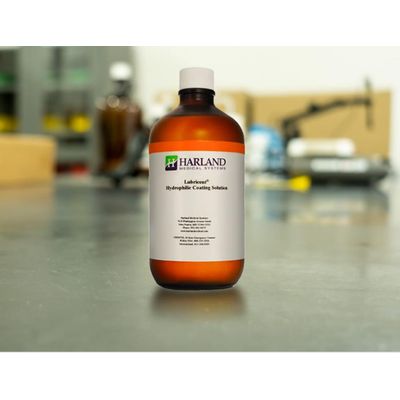

- Home
- Companies
- Harland Medical Systems, Inc.
- Products
- Harland Lubricent - Model UV - UV ...

Harland Lubricent - Model UV - UV Curable Hydrophilic Coatings
Harland’s Lubricent UV hydrophilic coatings provide exceptional friction reduction with state-of-the-art durability. Lubricent coatings enable catheters, sheaths, introducers, guide wires and other medical devices to navigate through the most difficult, tortuous vessels and anatomies. The solution blends a hydrogel-forming polymer with a proprietary photo-reactive compound dissolved in isopropyl or ethyl alcohol. With Lubricent UV coating on your device, you’ll get best in class lubricity and durability no matter the medical application.
A friction test of a Lubricent hydrophilic coated Pebax® 35D sample shows the resistance force needed to pull a coated sample between clamped rubber pads. The graph shows the superior lubricity and durability of Lubricent UV as compared to uncoated samples (typically measuring 400-600 grams of force) and PTFE coated samples (typically measuring at 100-150 grams of force).
* Testing was conducted on a Harland FTS Friction Test System with sample pinched between silicone rubber pads at 500 grams of clamping force.
Coatings 360Every medical device is unique and bringing it to market is a major challenge. That’s why Harland’s Coatings 360 approach tailors a complete answer to your distinct product coating needs and goals. We’re the industry’s only comprehensive source for high-performance coatings, equipment and production coating services—everything you need to coat your medical device on time and within budget. We provide it all in-house, so when you partner with us, you have one resource for everything coatings.
Reduces friction as much as 98%*
*Harland Medical Systems, Inc. Data on File
A photochemically- created covalent bond to the device substrate produces excellent adhesion and wear resistance
With multiple available formulations, Lubricent UV coating is compatible with most medical device surface materials
Coating cures rapidly with UV light, offering superior processing times compared to heat-cured coatings
Lubricent UV is compatible with most medical device substrates, including but not limited to:
Lubricent Substrates Chart
- Nylon (Polyamide): Polyimide
- PEBA (Polyether block amide): Polyethylene
- Polyurethane: Silicone elastomers*
- Polystyrene: Stainless steel*
*when paired with one of our Tylicent® Primer Solutions
Lubricent UV coatings have been successfully tested by an independent test facility against the ISO 10993 requirements for circulating blood contact; including cytotoxicity, irritation, acute systematic toxicity, hemocompatibility, allergenic potential and pyrogenicity.
Process FlexibilityLubricent UV coatings can be tailored to precisely meet your device’s surface performance targets. The process will then be validated by Harland Medical to prepare it for production at either your facility or in Harland’s ISO 13485-compliant coating services.
Regulatory SupportHarland Medical offers regulatory consultative support to help ensure the fastest path to get your device to market with a high-performance coating. Device Master Files and technical files are in place with the FDA and contain detailed to accelerate your regulatory submission through the FDA or notified body.
